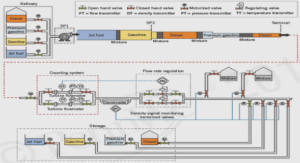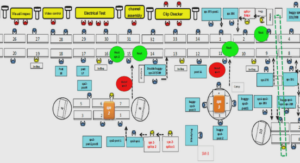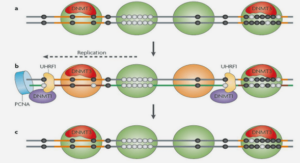Antioxidant activity and hepatoprotective potential of Cedrelopsis grevei on
cypermethrin
Background
Pesticides have been applied in agriculture and household to protect plants, animals and human from insects and vector diseases. The negligent and random uses of pesticides can cause environmental damage, food, water contamination, and health problems (e.g. cancer, nerve disease, birth defects). Cypermethrin (Cyp), a class II pyrethroid pesticide, first synthesized in 1974, widely used to control many pest species in agriculture, animal breeding and the household [1]. It has been reported that Cyp residues were found in the air, on walls and furniture after three months of household treatments [2]. Cyp was accumulated in adipose tissue, brain and liver of rats [3, 4] and has hepatotoxic potential in rodents [2, 5]. It crosses the blood–brain barrier and induces neurotoxicity and motor deficits [6]. However, due to the low toxicity of pyrethroids, persistence of these insecticides in mammalian tissues may be dangerous [3]. In fact, one possible mechanism of pesticide-induced toxicity is the production of reactive oxygen species (ROS) in the cell. ROS can alter oxidant/prooxidants statues and antioxidant defense system by increasing lipid peroxidation (LPO) and depleting the antioxidants in cell (enzymatic and non-enzymatic) which leading to a condition of oxidative stress [7]. It has been reported that ROS were involved in the toxicity of organophosphate insecticides (OPIs) such as chlorpyrifos [7] and pyrethroid insecticides such as prallethrin [8, 9] and a positive correlation with the liver damage has been reported. ROS, especially superoxide anion and hydrogen peroxide, are important signaling molecules in developing and proliferating cells, but also in the induction of programmed cell death [10]. ROS are transient species due to its high chemical reactivity that leads to the LPO and a massive protein oxidation and degradation [11, 12]. The author reported that ROS cause DNA damage and strand breaks as a result of modifying purines and pyrimidines bases by superoxide anion radical (O2 •- ), hydrogen peroxide (H2O2), and hydroxyl radical (HO• ). Cedrelopsis grevei is an endemic species in Madagascar. It was used in traditional medicine to treat malaria, fever and fatigue [13]. Our previous study [14] showed that sixty-four components were identified in C. grevei essential oil by GC-MS. The major constituents were: (E)-βfarnesene (27.61 %), δ-cadinene (14.48 %), α-copaene (7.65 %) and β -elemene (6.96 %). It exhibited antioxidant activities and concentration-dependent inhibitory effects on DPPH• and ABTS. Previous investigations of the trunk [15] and stem [16] bark of C. grevei showed that five coumarins i.e. norbraylin, methyl-O-cedrelopsin, cedrecoumarin A, scoparone and braylin were isolated. Atmaca et al. [17] showed that hepatoprotective effect of coumarins against oxidative stress and liver damage induced by carbon tetrachloride in male rats. In addition, phenolic compounds of C. grevei are playing an essential role in neutralizing free radical, quenching singlet and triplet oxygen, decomposing peroxides, stabilizing lipid peroxidation and protecting the cells against oxidative damage [18]. Currently, some synthetic antioxidant use to prevent free radical damage can induce side effects [19]. So, the dietary intake of natural products is considered very important for preventing a wide variety of diseases, including allergies, cardiovascular disease, certain forms of cancer, hepatic diseases, and inflammation, which involve free radical–mediated damage in pathologically generating processes [20]. Therefore, that is an essential research about suitable herbal drugs, that could replace the chemical ones [21]. However, the widespread use of C. grevei in traditional medicine stimulated us to explore its potential biological activity. To the best of our knowledge, no previous study of the antioxidant and hepatoprotective activities of C. grevei leaves extract have been reported. Therefore, the current study was designed to evaluate the antioxidant activity and hepatoprotective effect of C. grevei leaves against Cyp induced oxidative stress, lipid peroxidation and liver damage in male mice. Materials and methods Chemicals and reagents The assay kits used for biochemical measurements of aspartate aminotransferases (AST; EC 2.6.1.1.), alanine aminotransferases (ALT; EC 2.6.1.2), alkaline phosphatase (ALP; EC 3.1.3.1), lactate dehydrogenase (LDH; EC 1.1.1.27), catalase (CAT; EC 1.11.1.6), superoxide dismutase (SOD; EC 1.15.1.1), glutathione-s-transferase (GST; EC 2.5.1.18), glutathione reduced (GSH), malondialdehyde (MDA) and total protein were purchased from Biodiagnostic Company, Dokki, Giza, Egypt. Cypermethrin (95.1 %) was obtained from Jiangsu Yangnong Chemical Co., Ltd, China. All other chemicals used were of analytical reagent grade. All reagents were purchased from Sigma– Aldrich–Fluka (Saint-Quentin France). In vitro studies Plant material and extraction The leaves of C. grevei was collected from Toliara, Madagascar and identified by Benja RAKOTONIRINA (Institut malgache de recherches appliquées (IMRA), Madagascar). A voucher specimen (No. TLR 07) was deposited at the Herbarium of IMRA, Madagascar. The leaves of C. grevei collected in Antananarivo, Madagascar were ground to fine powder and successively extracted with solvents of increasing polarity (cyclohexane, dichloromethane, ethyl acetate, ethanol and finally methanol). Thus, 200 g of leaves powder were placed in steeping with cyclohexane (2 L) for 4 h under frequent agitation at ambient temperature and pressure. The mixture was Mossa et al. BMC Complementary and Alternative Medicine (2015) 15:251 Page 2 of 10 then filtrated using Wattman Paper (GF/A, 110 mm). The solvent was evaporated by rotary evaporation under vacuum at 30 °C. Then, the same powder extracted with cyclohexane was extracted again with the next solvent, dichloromethane, under the same conditions. The same protocol was applied for ethyl acetate, ethanol and methanol. Extracts were subsequently stored in sealed and amber vials at 4 °C for the following analysis.
Photochemical study
Determination of phenolic contents
The phenolic content of each extract was determined by Folin-Ciocalteu method [22]. Briefly, a mixture of diluted solution (20 μL) of each extract and 100 μL of FolinCiocalteu reagent (0.2 N) were prepared. The mixture was incubated for 5 min at room temperature and then 80 μL of sodium carbonate solution (75 g/L in water) was added. The absorbance was read at 765 nm, after 1 h against water blank. A standard calibration curve was plotted using gallic acid (0–300 mg/L). Results were expressed as g of gallic acid equivalents (GAE)/ Kg of dry mass.
Determination of flavonoids contents
The flavonoids were determined by Dowd method [22]. A mixture of diluted solution (100 μL) of each extract and 100 μL of aluminum trichloride (AlCl3) in methanol (2 %) were prepared. The absorbance of the mixture was measured at 415 nm, after 15 min. At the same time, a blank sample formed by methanol (100 μL) and extract (100 μL) without AlCl3. The results were expressed as g of quercetin equivalents (QE)/Kg of dry mass from calibration curve.
Determination of anthocyanin content
The absorbance of the extract was measured at 510 and 700 nm in buffers at pH 1.0 (hydrochloric acid–potassium chloride, 0.2 M) and 4.5 (acetic acid–sodium acetate, 1 M) [22] using 96-well plates. 20 μl extract solution was mixed with 180 μl of buffers and the wavelength reading was performed after 15 min of incubation. Anthocyanin contents were calculated using a molar extinction coefficient (ε) of 29600 (cyanidin-3-glucoside) and absorbance of A = [(A510 – A700) pH1.0 – (A510 – A700)pH4.5]. Determination of tannin content Proanthocyanidins reactive to vanillin were analyzed by the vanillin method [22]. One milliliter of extract solution was placed in a test tube together with 2 mL of vanillin (1 % in 7 M H2SO4) in an ice bath and then incubated at 25 °C. After 15 min, the absorbance of the solution was read at 500 nm. Antioxidant activity The free radical scavenging activities by DPPH● and ABTS•+ assays were evaluated according to the method cited by Afoulous et al. [14]. Total reducing capacity of C. grevei extracts was determined according to the method of Oyaizu [23]. One mL of extract at different concentrations (250–1000 μg/ml) were mixed with 2.5 ml phosphate buffer (0.2 M, pH 6.6) and 2.5 mL potassium ferricyanide [K3 Fe (CN)6] (1 %). The mixture was incubated at 50 °C for 20 min, and then a portion (2.5 ml) of TCA (10 %) was added to the mixture, which was centrifuged for 10 min at 1000 x g. The upper layer of solution (2.5 ml) was mixed with distilled water (2.5 ml) and 0.5 mL FeCl3 (0.1 %). Then the absorbance was measured at 700 nm. Ascorbic acid (0.5-10 μg/ml) was used as the reference compound. In vivo studies Animals and treatments Healthy adult male mice weighing 22.5 ± 1.0 g were obtained from the Animal Breeding House of the National Research Centre (NRC), Dokki, Giza, Egypt. Animals were housed in clean plastic cages in the laboratory animal room (23 ± 2 °C) on the standard pellet diet and tap water ad-libitum, a minimum relative humidity of 40 % and a 12 h dark/light cycle. Mice were allowed to acclimate to laboratory conditions for 7 days prior to dosing. The experimental work on mice was performed with the approval of the Animal Care & Experimental Committee, National Research Centre, Giza, Egypt, and international guidelines for the care and use of laboratory animals. Animals were randomly divided into six groups (six mice each), control, Cyp, extract (150 and 300 mg/kg. b.wt), Cyp plus extract (150 or 300 mg/kg. b.wt) groups. Cyp and C. grevei extracts were administered by gavages in a fixed volume of 0.1 ml/mice daily for 28 days. Cyp was dissolved in corn oil and given via oral route at dose 13.8 mg/kg b.wt 1/10 LD50 [24]. C. grevei extracts were dissolved in water and given via oral route at dose 150 and 300 mg/kg b.wt. Dosages were freshly prepared, adjusted weekly for body weight changes, while a control group was received corn oil.





